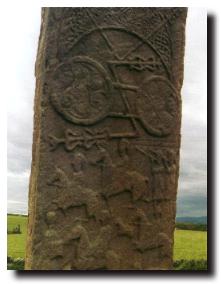For a small country, Scotland has had a number of languages over the years and a number of confusing terms used to desribe them. Here's a brief outline.
 When the Romans arrived in Scotland in 80AD, neither Gaelic nor English were in use. The language used was a form of "Brythonic" which can best be described as early Welsh.
When the Romans arrived in Scotland in 80AD, neither Gaelic nor English were in use. The language used was a form of "Brythonic" which can best be described as early Welsh.
North of the Forth/Clyde valley the Picts spoke a variant of this language (though as they left no written records, apart from a list of kings written in Latin, plus their stone symbols carved in stone (see above), the precise nature of their language is unknown).
Later the Angles, Saxons, Jutes and Frisians, speaking Germanic dialects, advanced from the Humber estuary as far as the Firth of Forth.
Meantime, the Scots from Ireland were establishing themselves in Argyll in the west - eventually they overcame and merged with the Picts, obliterating their identity and establishing Gaelic as the language of the Highlands. In the 9th century, Kenneth mac Alpin expanded his kingdom south of the river Forth to the river Tweed. One of his daughters married into the royal family of Strathclyde and this eventually resulted in that kingdom becoming part of Scotland. Thus, by the 10th and 11th centuries, Gaelic was the main language over much of Scotland.
By the 9th century Scandinavian Vikings were invading much of the western and northern coastline and in Orkney and Shetland Islands in the north, settling and introducing elements of their language.
In the second half of the 12th century, King Malcolm III (known also as Malcolm Canmore) married Margaret, a descendant of the English King Alfred. She introduced English into the court. Anglo-Norman English had already been encroaching, encouraged by the Norman and Flemish aristocracy who were granted land by King David I (who had spent his formative years in the English court). Eventually, the common people came to speak a type of Northern English which, with Viking influences, developed into Scots. Thus Scots was derived, like English, from "Old English", the language of the Angles, a Germanic tribe who crossed the North Sea and became established on the east coast of what is now England.
In the 13th to 16th centuries the links with France and the "Auld Alliance" resulted in a number of French words coming into the Scots language.
The Union of the Crowns in 1603, the King James VI bible and the Union of Parliaments in 1707 hastened the demise of Scots. Lists of "Scotticisms" were drawn up - Scots words to be avoided by the educated classes.
Scots ballads and poetry survived longer and poets such as Rober Burns (1759-1796) kept the language alive in that form.
Lallans is the name given to the variety of Scots spoken in the Scottish Lowlands (it comes from the Scots word for Lowlands). There is also a "literary" version, referred to as Lallans, used by some 20th century Scottish writers (notably Hugh MacDiarmid).
At one time, the term "Doric" (derived from a form of Greek spoken by the Dorians) was used to describe any rural dialect of English, but especially from the Scottish Lowlands. But is now applied only to the dialect of the north-east of Scotland in Aberdeenshire.
Around 1% of people living in Scotland today speak Gaelic. It is estimated that, as a result of immigration, there are more people in Scotland speaking the languages of the Indian sub-continent than speaking Gaelic.



